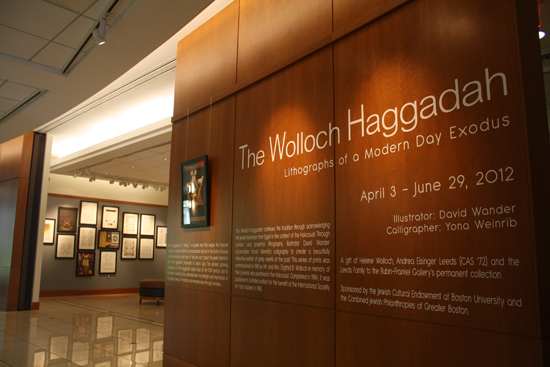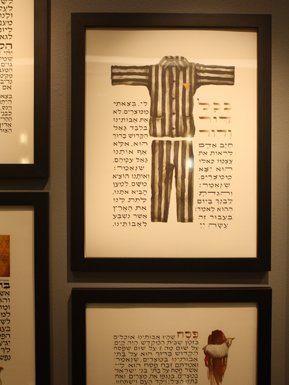Remembrance as the Secret of Redemption
Hillel House exhibition links Exodus and Holocaust

The Wolloch Haggadah is on display at the Rubin-Frankel Gallery through June 29. Photos by Tom Vellner (COM’13)
Thousands of years separate the exodus of the Jews from Egypt and the recent catastrophic horror of the Holocaust, but these two seminal events in Jewish history bear striking parallels of deprivation and suffering. A new exhibition at the Florence and Chafetz Hillel House Rubin-Frankel Gallery, titled The Wolloch Haggadah: Lithographs of a Modern Day Exodus, explores the link between the two events.

Commissioned in 1981 by Zygfryd and Helene Wolloch in memory of their parents, who perished in the Holocaust, and completed in 1984, the exhibition comprises 55 hand-printed original lithographs, signed by illustrator David Wander and calligrapher Yonah Weinrib. Now part of the gallery’s permanent collection through a gift from Helene Wolloch, Andrea Eisinger Leeds (CAS’72), and the Leeds Family, these lithographs illustrate the Haggadah—a collection of prayers, blessings, and excerpts from the Hebrew Bible, Mishnah, and Midrash that commemorates the Israelites’ exodus from ancient Egypt. This series of lithographs also honors those Jews killed during the Holocaust. Strong themes of oppression and freedom are deeply rooted in the compilation, exemplifying the parallels between the Exodus and the Holocaust.
“They are both significant stories in our Jewish history, and like all instances of horrific violence and enslavement, if you forget what’s happened, it’s bound to repeat itself,” says gallery director Holland Dieringer (CFA’05). “Reminding people of that visually can be incredibly powerful.”
The Haggadah is read at the beginning of each Passover to fulfill the Book of Exodus commandment that all Jews must pass on the story of the Israelites’ liberation from slavery in Egypt to their sons. What began as an oral tradition here takes on a profoundly visual presence. In the lithographs, the text of the Haggadah appears alongside images, such as a concentration camp uniform bearing the yellow star of David, that recall the atrocities of the Holocaust.
A different image, this one depicting a pile of suitcases, draws yet another visual connection between the two events: the suitcases are arranged in the shape of a pyramid, a reference to the flight out of Egypt, while the luggage itself represents the material belongings stripped from Jews upon arrival at concentration camps. One of the most compelling lithographs shows lightning bolts striking a sea of red waves and pyramids, symbolizing the parting of the Red Sea during the Exodus and the spilling of blood during the Holocaust.
While each lithograph is somber in tone, says Dieringer, when taken collectively, they tell another story: of embarking on a dark journey and arriving at a place of hope for the future. Seen as a whole, the work sends a message that by remembering a past scarred with oppression, an emotional and spiritual liberation is possible.
Dieringer points to a quotation attributed to the 18th-century Jewish mystical rabbi Baal Shem Tov to best signify the purpose of The Wolloch Haggadah: “Forgetfulness leads to exile, while remembrance is the secret of redemption.”

As the Holocaust recedes into history, she says, it becomes increasingly imperative to remember the six million Jews who died in the ghettos and camps. “It needs to be a constant effort,” she says. “People need to constantly ask themselves what their role is, what their responsibility is. Do you take responsibility as a Jew or simply as an individual who’s compassionate towards human life? It needs to be asked.”
At the exhibition’s opening reception earlier this month, the wife of a Holocaust survivor told Dieringer that she was amazed by the lithographs and appreciated the profound visual connection they made between the two events—one that couldn’t be accomplished with just words.
The Wolloch Haggadah is a show that speaks to all people, Dieringer says, regardless of their faith. “The point isn’t whether you understand the Hebrew. The craft of the art can be appreciated by anyone,” she says. “I hope that visitors walk away with some insight, and with a connection that they’ve never made before.”
The Wolloch Haggadah: Lithographs of a Modern Day Exodus is on display at the Florence and Chafetz Hillel House Rubin-Frankel Gallery, 213 Bay State Rd., until June 29. The gallery is open Monday through Saturday from 9 a.m. to 9 p.m. and Sunday from 3 to 9 p.m. The exhibition is free and open to the public.
Tom Vellner can be reached at tvellner@bu.edu.
Comments & Discussion
Boston University moderates comments to facilitate an informed, substantive, civil conversation. Abusive, profane, self-promotional, misleading, incoherent or off-topic comments will be rejected. Moderators are staffed during regular business hours (EST) and can only accept comments written in English. Statistics or facts must include a citation or a link to the citation.